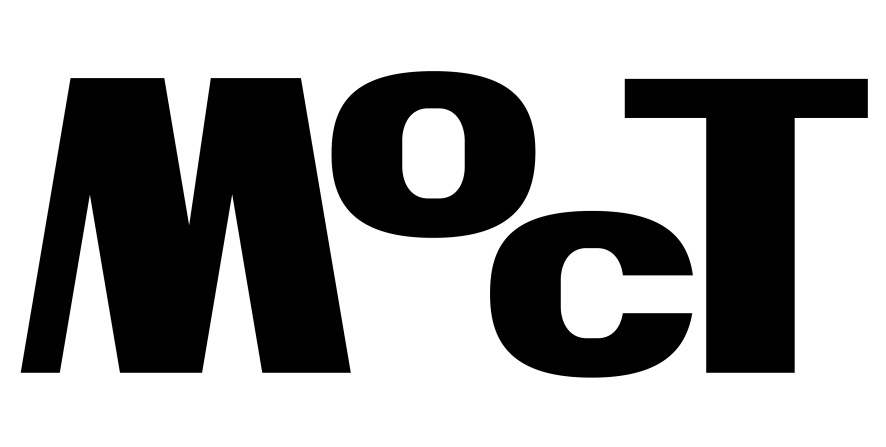Oleksii Minko
In physics, space is presented as a realm of interpenetration between the small and the large, the distant and the close, the internal and the external. The theory of entanglement asserts that, despite distance, objects can be interdependent and react to changes even if they are not directly influencing each other. Using experiments and concepts from modern physics as metaphors can be incredibly helpful when creating an exhibition where interconnectedness takes center stage. Through them, discussions about the perception of safety, solidarity, and collectivity, and the relationship between the local and the global can take on a tangible dimension. This is what happens with the exhibition Sense of Safety, which unites the works of Ukrainian (mostly Kharkiv-based) and international artists around such themes, focusing on the analysis of social and political infrastructures that (at least attempt to) ensure safety.
In addition to its relevance to the themes of the exhibition, quantum physics also holds significance for both the city and the venue hosting the event. Kharkiv is a city where renowned figures in the physical sciences, such as Lev Landau and Igor Kurchatov, worked for many years, and the exhibition itself is located in the basement shelter of the Karazin Kharkiv National University, which, among many other faculties, also houses the Faculty of Physics. This exhibition space belongs to the YermilovCentre – Kharkiv’s contemporary art center, which has been organizing exhibitions, educational programs, and performative musical events since 2012, and stands as one of the city’s main professional and strategically-minded cultural platforms. The YermilovCentre has continued its activities throughout the full-scale invasion. During the first months of attacks on Kharkiv, it served as a shelter for artists. Many of them, including Pavlo Makov, who is featured in this exhibition, lived at the centre during this time. YermilovCentre has been, and remains, a reliable refuge from Russian shelling, which often strikes the city center, where it is located.
In the exhibition guide for Sense of Safety, curators Aleksander Komarov, Marina Koneva, Tatiana Kochubinska, Antonina Stebur, and Maxim Tyminko directly reference the paradigm of quantum physics, positioning the artworks at the intersection of six “force fields”, for example Infrastructure of Care, Asynchrony and Dream Museum, and Interdependency and Collectivity. The curators also invite viewers to build up their own force fields by moving through the exhibition in any direction, randomly, like atoms in Brownian motion.
The arrangement of the works in the exhibition reflects this chaotic movement: video works are constantly in motion. They switch their places with each other with the help of a spontaneous algorithm, independent from the captions under the frame of projection, seemingly echoing Landau’s repeatedly contemplated concept of superfluidity, where helium-4, at certain temperatures, flows without friction, retaining energy. One video transitions from screen to screen like a liquid fluidly passing through a vessel, as if the massive building was somehow suspended. At the same time, as the videos pass through walls, they discharge the density of the shelter, bringing practices of mutual care to the forefront and filling the space. Just as the solid walls protect from shrapnel, the sense of safety moves and flows between the shelter’s supporting columns. And safety directly depends on solidarity. While it can be measured by outcomes, its presence is primarily distributed among bodies. This idea is captured in the work titled after a quote from Marx and Engels, All that’s solid melts into air. Kharkivian artists Yulia Kostyreva and Yuriy Kruchak install rotors with video cameras in various cities around the world. A gust of wind in one of these cities sets the main rotor in Kharkiv into motion, and the airflow from another part of the world fills YermilovCentre. Marx and Engels’ metaphor, concerning the rapid pace of revolutionary change brought by the rise and spread of bourgeois dominance is used by the artists literally: the support of Ukrainian resistance can lead to the interception of heavy shells in the air, and the walls dividing institutions will no longer be barriers to participation in the fight against imperialist violence.
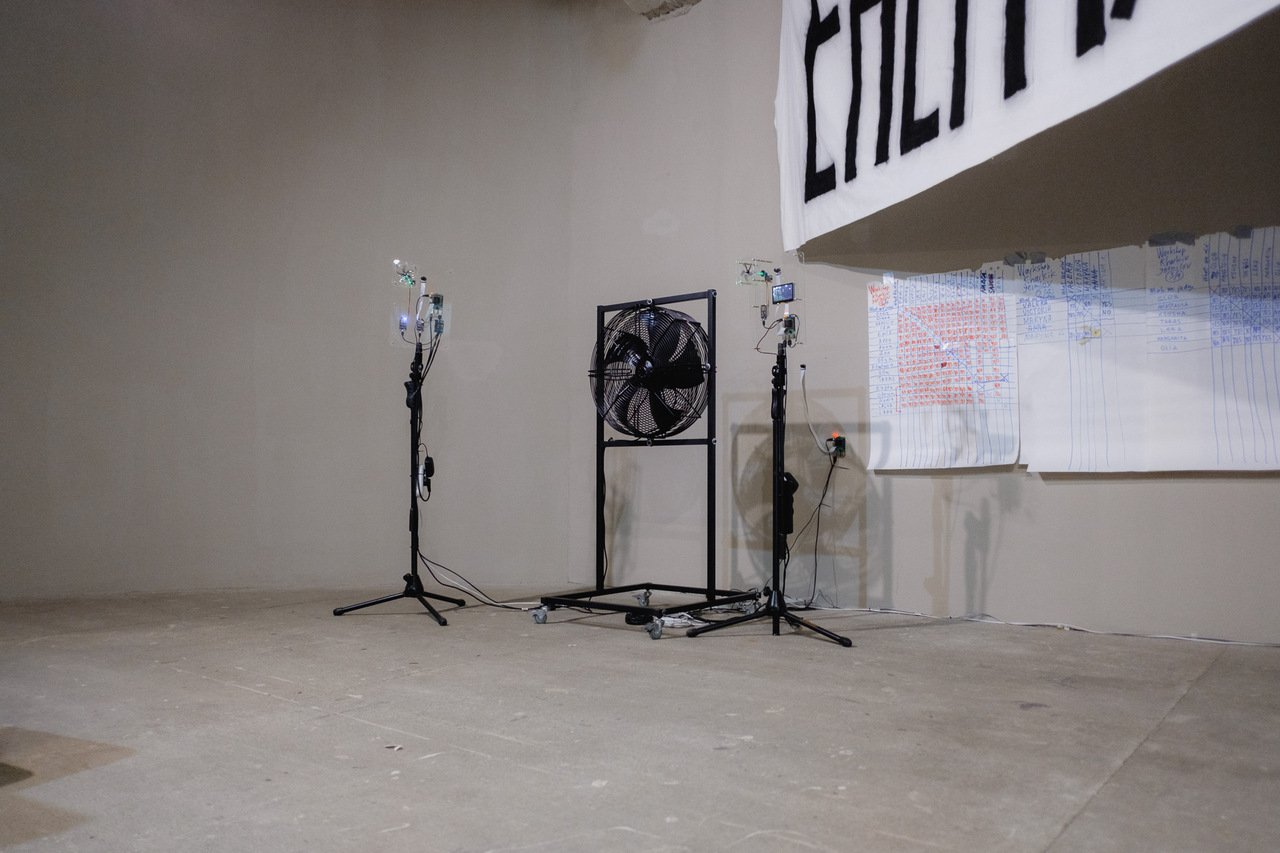
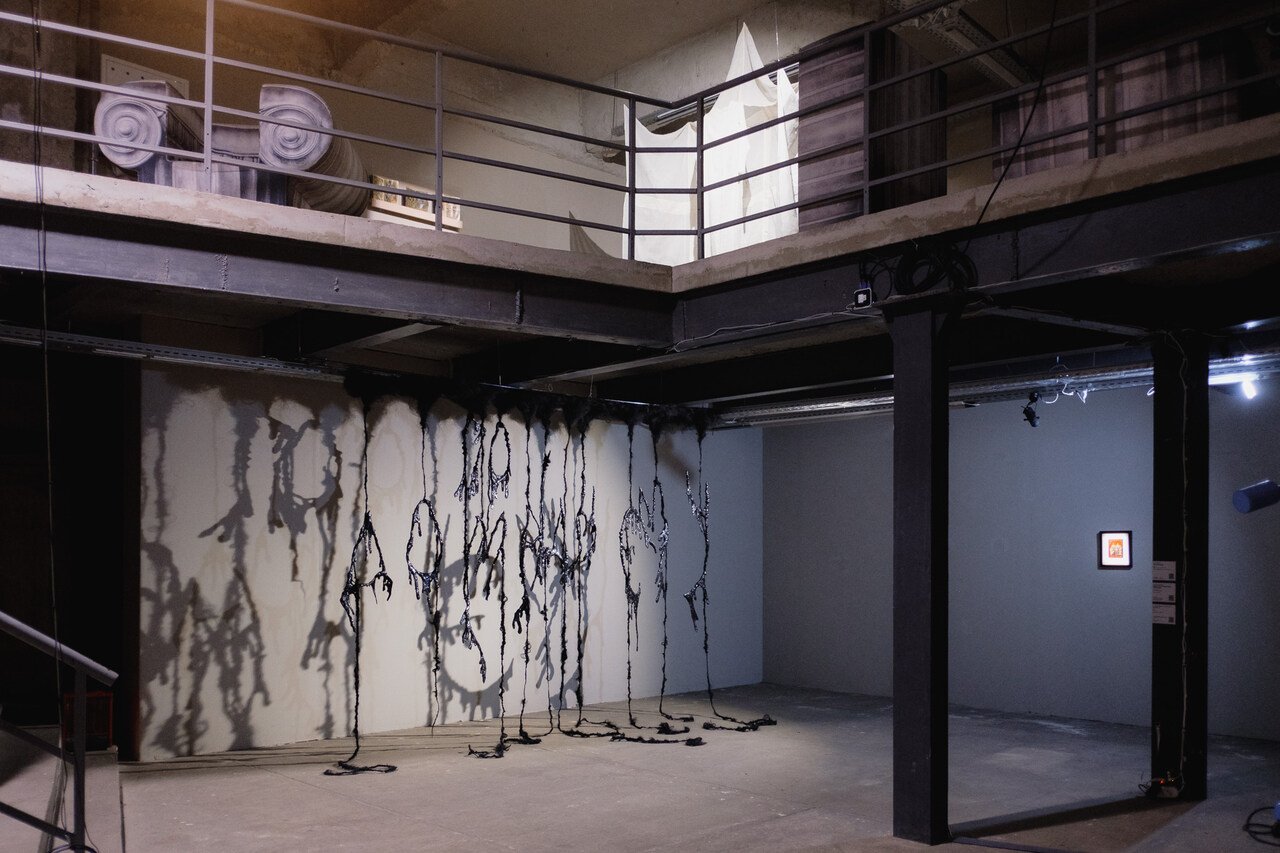
In addition to the protective density of the walls, the surfaces of YermilovCentre are filled with another substance – a blackness, creeping into the shelter through shadowy corners. Like mold, it persistently erodes the supporting structures from within: surface removal only provides temporary relief while the roots continue to remain active. This sticky darkness feels like a threat, infiltrating the zone of safety and setting up its home, claiming the space and reminding one of the possibility of return. Alina Kleitman’s black stalagmites, made from bags that Russian soldiers use to transport the bodies of their dead, are aptly titled Homely, directly referencing a viral video known to every Ukrainian. In it, a crying Russian woman, fleeing from the Ukrainian counter-attack, tearfully says, “It’s so soulful, so homely.” She is sad to leave the resorts of the Russian-occupied Crimean Peninsula, which she had grown fond of.
The cool breezes of support and the mold of violence fills the same space, and separating one from the other is difficult. They are locked in a struggle, shaping each other. The cold, bare walls of the shelter are warmed by winds of solidarity, pushing down the darkness. Danger and safety bend and fold into one another, leaving their marks on everyday life. The keen gaze of artist Taras Kamennoy, in its excessiveness – he presents unnecessarily scrupulous documentation of the house close to the frontline that reminds him of a museum, hidden due to the risk of aimed shelling – confuses crumbling old roofs with evidence of shell impacts. A simulated detailed photo investigation paradoxically leads to the complete indistinguishability of traces. In the frontline zone, Iryna Loskot discovers tree bark that absorbs camouflage, designed to blend into the natural environment. Francis Alÿs documents children who have internalized checkpoint protocols and demand a password from neighbors passing through a Ukrainian village.
Reflecting the mixture and entanglement of forces, the works in the exhibition form a moving and ever-shifting network from which the viewer weaves their thread. The more the viewer notices the tensions between opposites, the more intensely the emerging force fields begin to relate to one another. The concentrated mass within these fields generates various spatial-temporal effects. In turn, these effects allow for a deeper understanding of the mechanics of the local political and social contexts, with their asynchronies and asymmetries.

Long-Range Interaction
Rosalind Krauss writes about the effect that the architecture of contemporary art centers has on viewers, describing it as something that displaces the materiality of contemporary art and, consequently, its political power[1]. Since the late 20th century, the art-architectural complex has become a site of neutralizing historicity with spectacular spaces of universalizing globality[2]. Contemporary art theorists and critics often problematize the totalitarianism of the “contemporary,” which the museum today produces. They suggest returning historiographical analytical depth to museum institutions to maintain the possibility of engaging with both the past and the future, thereby escaping the economically driven necessity of working exclusively with the present[3].
Sense of Safety, in the expansive, self-sufficient, and unique spaces of YermilovCentre, resists the spectacular potential emptiness of space by subordinating every interval to the contemporary historical moment – the material context of war, shelter, and survival infrastructure. The works in this exhibition are acts of participation and involvement rather than mere presentations of new art. Many of the invited artists donate their works to the center’s collection, thus laying its foundation. And the exhibition itself is an act of care: a QR code in the booklet collects donations for building inclusive infrastructure in YermilovCentre, a need that has grown due to the many injuries sustained by city residents and veterans during the full-scale invasion. Nothing in the exhibition exists purely for contemplation. The timelessness of the universal white cube space is replaced by the pragmatism of the bare concrete walls of the shelter. In the dire situation of an exhausting defensive war, the intersection of art and politics becomes more visible than ever. One can see where and how they touch each other.
The works by Ukrainian artists in this exhibition mainly reinforce the notion of the gallery space as a shelter. They defend the necessity for refuge: creating it in fantasies, as Karina Synytsia does, or, like Katya Lesiv, physically building it within the exhibition space. The curators and artists offer the audience both a physical shelter and a safe space for representation and recognition of experience. The works of Kateryna Yermolaeva, Olena Afanasieva, and Maks Afanasyev, which convey personal encounters with the hardships of shelling and occupation, are closest to the local experience and provide Kharkiv residents with affirmation and understanding.
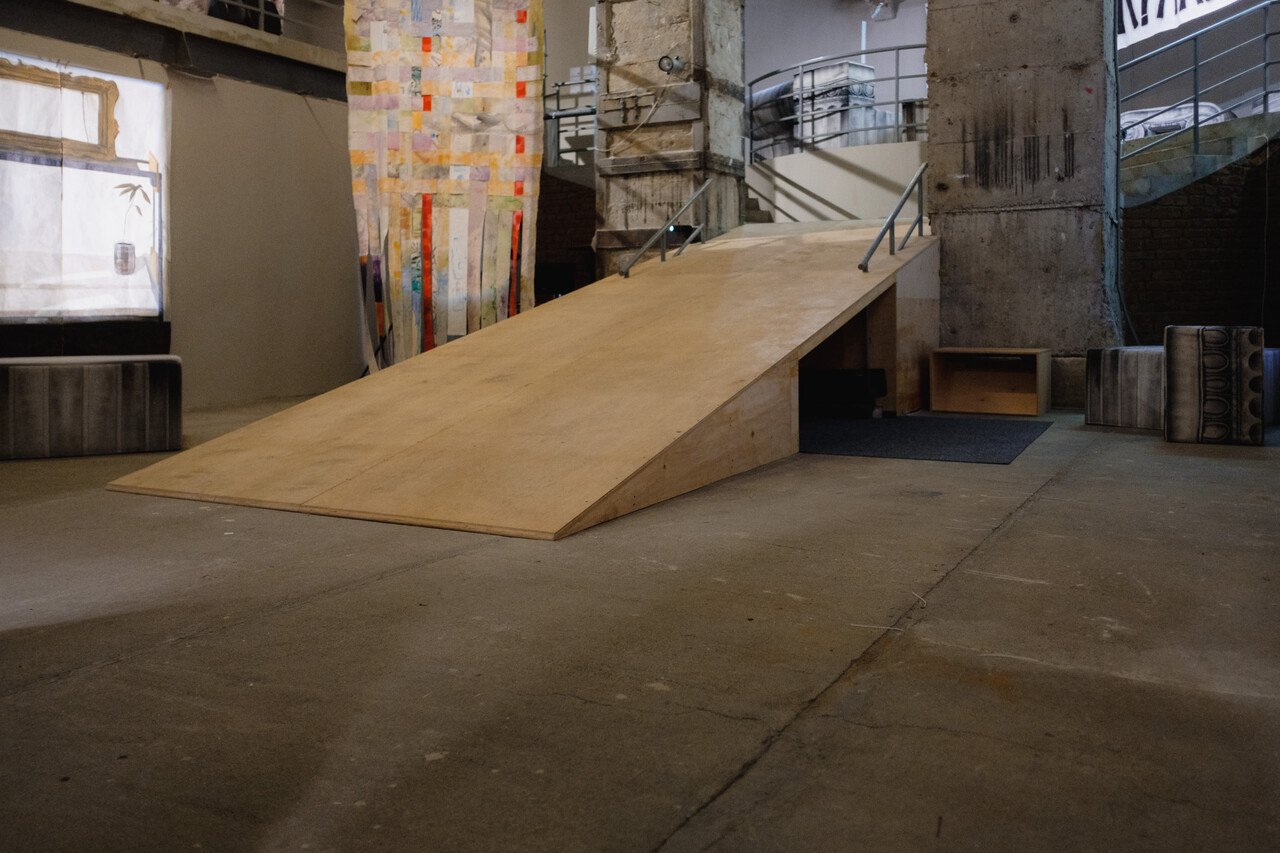
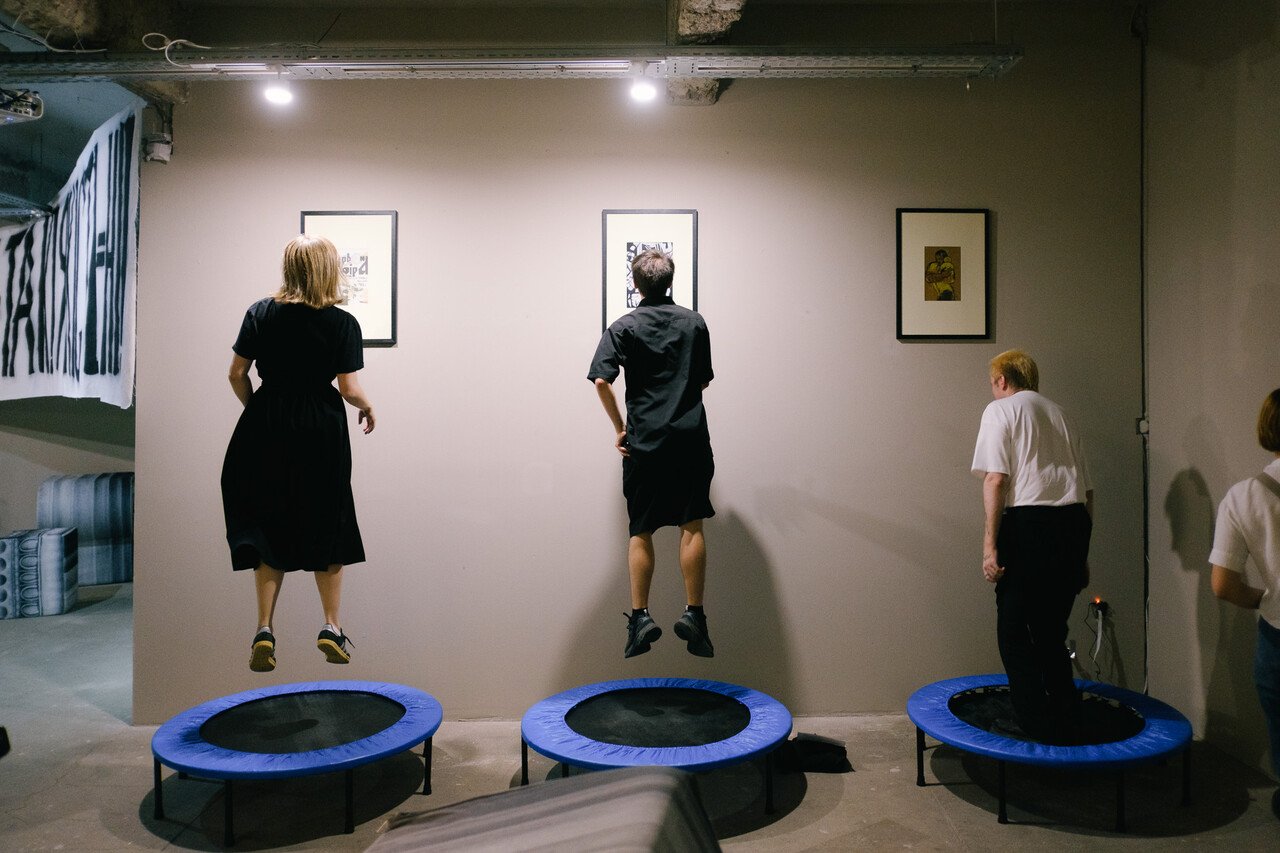
An exhibition within a bomb shelter is naturally subordinate to the needs of the inhabitants of a specific city, country, or situation. And it is all the more interesting to observe how artists from a universalized and universalizing context relate to this policy of the particular and the local. Foreign artists respond to Ukrainians with gestures of support for this sharp localization, acknowledging the gap in the imagination of global peace. Andreas Angelidakis donates his soft ruin columns to YermilovCentre, which are used in the exhibition as seats for viewing the works and for moments of respite from the labor of spectating. During bombings, when YermilovCentre fully functions as a shelter, this gift becomes especially valuable, as many people long for both rest and decolonization at the same time. Ahmet Öğüt’s installation Jump Up! in the form of trampolines, easily brings a smile – first upon seeing them and then after one makes their first jumps. By turning Kharkiv’s bomb-shaken ground into a playground, Öğüt relieves a tension but, at the same time, does not allow one to forget what is happening around, embedding the surrounding reality into the chain of previous catastrophes. The trampolines are placed opposite Öğüt’s replicas of significant Ukrainian works (a collage by poet Serhiy Zhadan, a sketch by monumental artist Alla Horska, and a painting by Zoia Lerman). Öğüt calls this gesture Safe Return of the Evacuated, offering YermilovCentre to keep these copies on the wall until the originals return home. Rather than donating a new piece to a collection of solidarity (such collections have been assembled, for example, with contributions from international artists for earthquake-stricken Skopje, Serbian-destroyed Sarajevo, or permanently attacked Gaza), Öğüt chooses to care for what already exists but is currently in evacuation. He suggests preserving it, even if only in the form of a copy.
One of the events during the exhibition’s opening was the visit of Swiss artist Thomas Hirschhorn, who gave a lecture and led a series of workshops. His journey to Kharkiv and stay there became the subject of his artistic and personal research. At the exhibition, he displayed a sign, “Energy = Yes! Quality = No!” This slogan guided his workshops, which focused on identifying energy in artworks or creative artifacts that participants brought. The equality of expression and the opportunity for everyone to speak and show their work made any form of teaching or paternalism impossible. However, in a reflective Instagram post after leaving, his objectivizing distance became apparent. For Hirschhorn, these meetings were part of his observation of how war complicates the critical assessment of art and narrows its critical potential[4]. In this way, his privilege revealed itself: the universal category of Criticism, according to Hirschhorn, must remain intact, no matter where or when.
As someone who frequently works with images of destruction and war, Hirschhorn listened to people from the frontline city and attempted to understand its condition, refraining from rushing to offer Ukrainians advice or evaluating their situation. So, where does the dissonance in his conclusion come from? This is the problem of communicating first-hand experiences, and there is a relevant artwork about it in the exhibition. In her video, Rhona Mühlebach whimsically conveys the experience of an artist communicating with a crow. Successful moments of connection do not always end in mutual understanding, and the experiences and ways of living and interacting between species are fundamentally unknowable to one another. Such communication is filled with uncertainty and threat, and the potential for a false sense of mutual understanding. Similar challenges arise in the interaction between Ukrainians and international professional communities.


The sharpest differences are felt in the meditation by Danilo Correale. One part of his video series, Dream: Liberation from Labor, was created to emphasize the contrast between an envisioned world of equality and justice and the real situation. In Sense of Safety, this contrast takes on a darkly humorous tone. Capitalism not only exploits resources, leading to crises in human communities, but it also reinforces new imperialisms and dictatorships that thrive precisely because of extractivist strategies. Against this backdrop, the video poses a challenge: to imagine a post-labor society just outside the doors of YermilovCentre. After the meditative repetition of this proposition, stepping out into Kharkiv does not bring the joys of a post-labor world but instead greets one with missiles assembled from parts sourced globally, which have been striking the city’s central areas for more than two years. In the European context, Correale’s works generate a sense of outrage at the discrepancy between reality and the ideal, leading to transformative action. In Ukraine, however, this takes on a distinctly ironic dimension. Of course, the problem of precarity is closely tied to what Ukrainians are experiencing, but even that does not come close to the intensity and excessiveness of their current reality.
Times of the Collection
Old works return and begin to function differently. Boris Mikhailov’s Overlay, one of the pieces in his series Yesterday’s Sandwich, is a formal experiment from the Soviet era that has now turned into a prophecy of the brutal reality of contemporary life. Museum of Modern Life, developed by Pavlo Makov in the 1990s, finds new meaning in the context of full-scale war. During the first months of the invasion, Makov was among those using YermilovCentre as a shelter. The artists who stayed there built makeshift beds out of plywood and settled in the space. One of these beds is displayed by Makov against a wall, turning his temporary home into a museum exhibit. Nearby, he hangs his early works featuring target patterns that resemble the silhouettes of residential buildings. This image, which took on a catastrophic dimension during the Yugoslav wars, returns in the context of the Russian-Ukrainian war. As destruction easily penetrates any home, the ominous prophecy of the target-home image becomes part of the domestic interior, simulating the illusion of comfort. Makov’s domesticated gallery corner serves as a reminder of YermilovCentre’s function during missile threats that simultaneously transforms the entire space, and indeed the entire bombarded city, into an installation.
Einstein’s theory of relativity suggests that massive objects can bend the flow of time. One could speculate that the massive missile attacks on Ukrainian cities, with their hypersonic speeds and the heat of exploding shells, have twisted time in such a way that the future has become recognizable only through the past. The interaction of gravity and explosive materials has complicated the relationship between the three major points in time: past, present, and future.
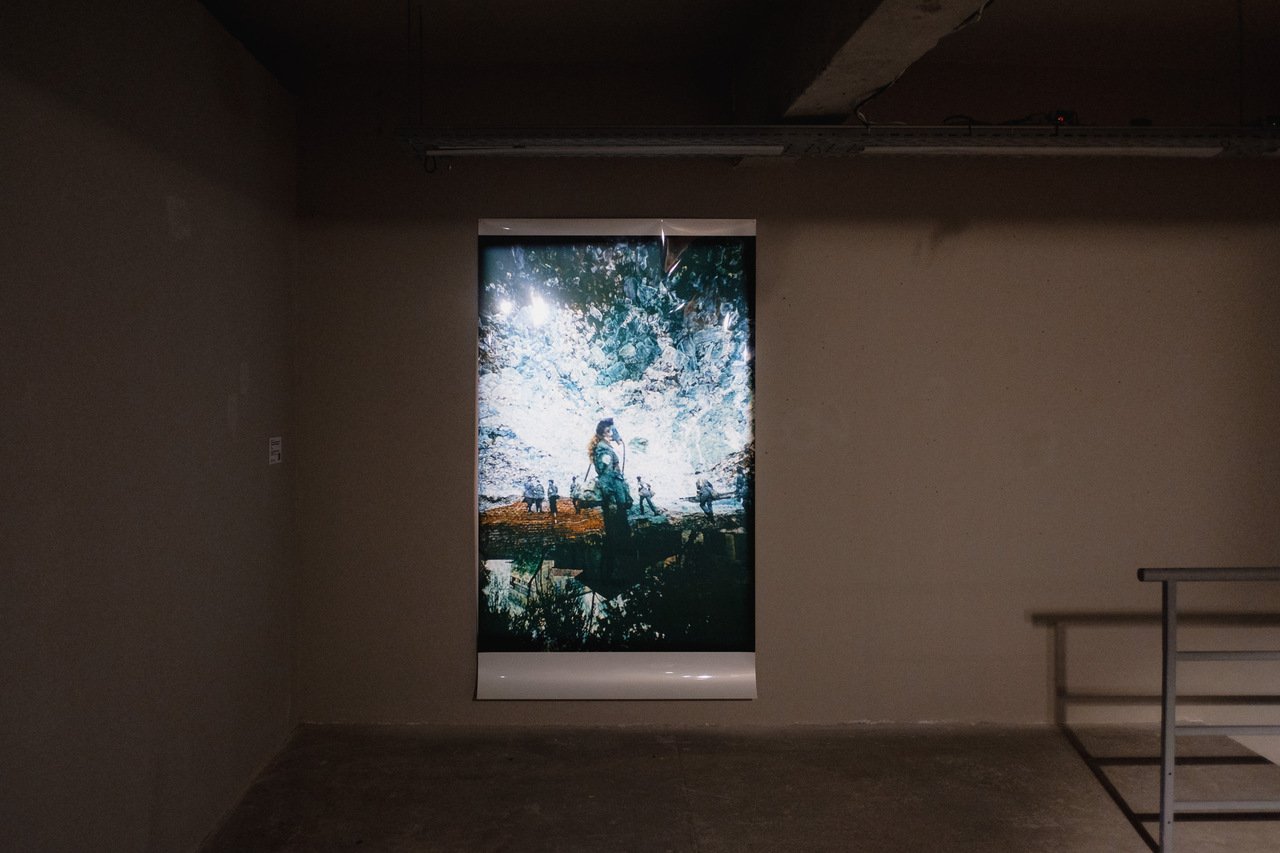
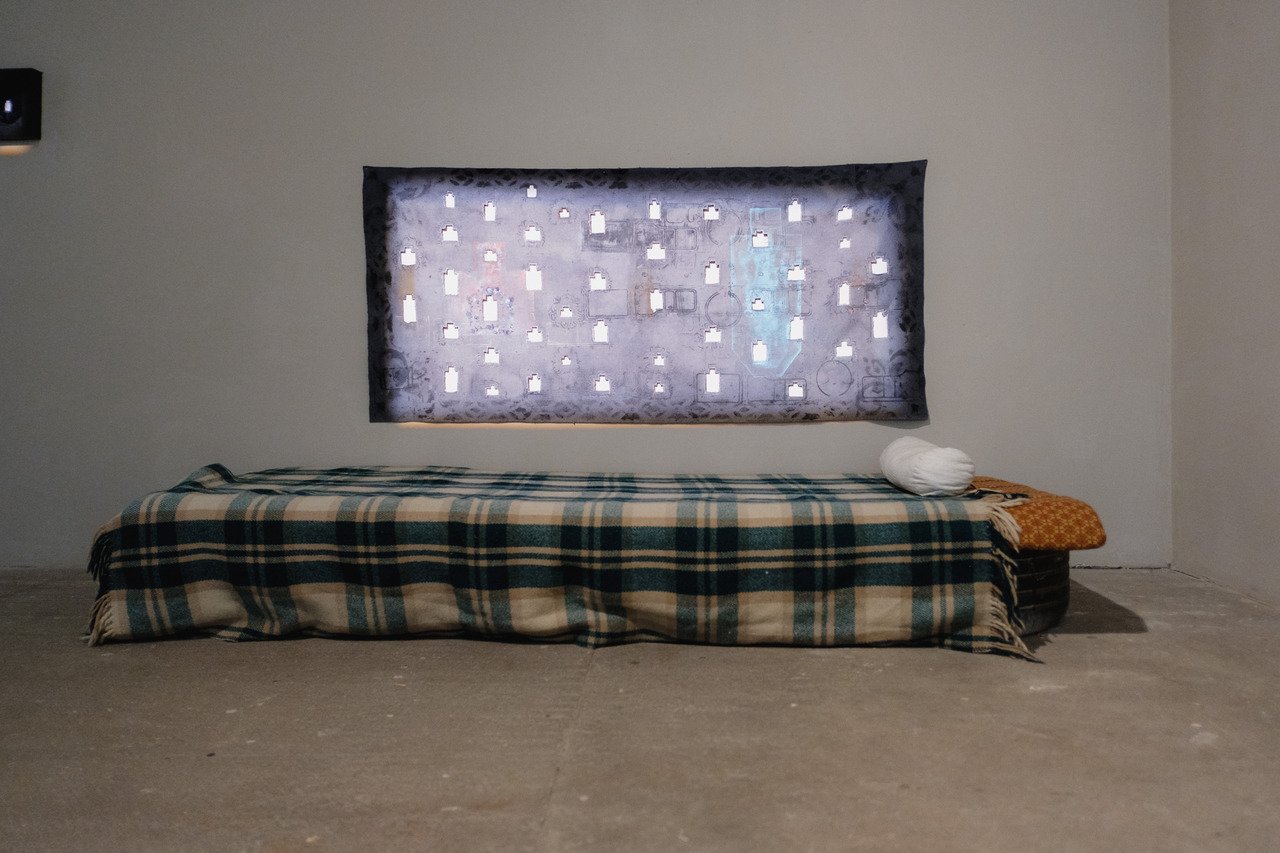
Over the three years of full-scale military actions (and even a bit before that), Ukrainians have listened to countless forecasts and learned to think simultaneously in multiple perspectives, often pessimistic, fatalistic, or fanatical. This has created a particular understanding of the historical process in which a Russian attack on NATO countries seems like an inevitably approaching moment. Therefore, the denial or ignorance of this forecast by Ukraine’s allied countries is shocking and painful. Moreover, Ukrainians themselves are divided in their experience of time and history. After spending several days under MLRS shelling in Kharkiv, moving through the streets of residential areas in total darkness, and encountering people on public transportation who are literally losing their minds, it becomes clear that for Kharkiv residents, solidarity is far from a closed chapter. The question of how to live in defiance is still overshadowed by the more immediate question of how to survive today. The present reflected in the exhibition might seem delayed even for Kyiv, where the days of living in the metro are seemingly past, the streets are lit at night, and checkpoints are only found on the city’s outskirts. In Ukrainian cities, time is distributed differently depending on proximity to the mass of warheads falling from above.
Joking about the careless remarks of fellow citizens regarding his quick departure from the front due to a back injury, artist Bohdan Bunchak bitterly refers to the period between mobilization and demobilization as a “quantum leap from the past to the future.” His text for the work, You Ain’t Even Try, reflects his dissatisfaction with himself and those around him in the face of war, and ends with the words: “I saw the future, and we didn’t lose there. Amen!”[5]. Although Bunchak’s work is not part of the exhibition, this metaphor serves as a perfect indicator of the spatial and contextual meridians that divide Ukrainian experiences, including their temporalities. Milena Khomchenko, referring to Ukrainian thought leaders, writes about the “desynchronization within Ukrainian society depending on the level of experience and involvement in this war.”[6]. Ukraine, in a state of war (including its periphery in the form of a big part of the rest of the world), is a time machine in which movement between communities and cities is equivalent to spatio-temporal leaps.
These differences are likely to deepen further. And this doesn’t necessarily need to be interpreted in a catastrophic tone. Multiple layers and intersections become possible and can lead to diverse and rich experimental experiences. But this situation places high demands on art and even more so on the collections being formed. Whose experience will the collection reflect? The rear, the military, the immigrant, the foreign? Will the collection aspire to unite these experiences? Can the collection be quantum, entangled among its objects as much as the times with which these objects are imbued? Can such a collection hold onto the “disjunctive unity of present times”[7]? And what will this collection offer to the “external” viewer after the modernist and postmodernist collections of Skopje, Gaza, and Sarajevo, each marked by their unique temporalities? Though not yet fully formed, the Kharkiv collection is already speaking and asking: What if the modernity that followed 1989 is not the modernity of “presentism,” ever-new and ever-renewing, but is rather a stoppage of time, like that which is often described by witnesses of life and death on occupied and frontline Ukrainian territories? Moving from Yugoslavia through the Middle East and stretching to Ukraine, this modernity of halting and stasis, from a Ukrainian perspective, feels like the world’s future. Not the stasis of excess and the end of history familiar to citizens of Western Europe, but one within an exhausting and dangerous history that repeatedly, endlessly, threatens to claim the lives of hundreds of thousands. Indeed, in this historical context, solidarity and interconnectedness remain the only way to occasionally, even if just for a few minutes, experience a sense of safety.

Oleksii Minko. Writer and interdisciplinary artist. Born in 2000 in Berdyans’k, Ukraine. Based in Kyiv. His interest lies at the intersection of art theory and political philosophy. His texts have been published in LB.ua, Supermova, Visible Ukraine, and Artslooker.
[1] Krauss, Rosalind. “The Cultural Logic of the Late Capitalist Museum.” October 54 (Autumn 1990): 3–17.
[2] Foster, Hal. The Art-Architecture Complex. London: Verso, 2013.
[3] Bishop, Claire. Radical Museology, or What’s Contemporary in Museums of Contemporary Art? London: Koenig Books, 2013.
[4] thomashirschhorn_official. “The ‘Art = Shelter’ in Kharkiv.” Instagram, September 4, 2024. https://www.instagram.com/p/C_fpX4iiof0/.
[5] The Naked Room. “‘Ти навіть не намагаєшся’ — 28 червня запрошуємо…” Instagram, September 21, 2024. Accessed September 21, 2024. https://www.instagram.com/p/C_fpX4iiof0/?img_index=1..
[6] Хомченко, Мілена. “Непідвладне, невидиме, несвідоме: Мілена Хомченко про кураторську виставку Нікіти Кадана та великі виставкові проєкти”. Суспільне Культура, 4 вересня 2024. https://suspilne.media/amp/culture/827035-nepidvladne-nevidime-nesvidome-milena-homcenko-pro-kuratorsku-vistavku-nikiti-kadana-ta-veliki-vistavkovi-proekti/?fbclid=PAZXh0bgNhZW0CMTEAAaYpjArngr12o9TqSYaOjO2_H7voXHPRKIK3X0sMkjDQIGmNfnhTezFYpys_aem_DyTRBPCu70FM8_3FUI70Xg.
[7] Osborne, Peter. Illusions of Totality. Global Contemporaneity and the Condition of the Museum. MODOS. Revista de História da Arte. Campinas, v. 2, n.3, p.91-100, set. 2018. Disponível em: ˂http://www.publionline.iar.unicamp.br/index.php/mod/article/view/18 62˃; DOI: <https://doi.org/10.24978/mod.v2i3.1862>
Artists: Olena Afanasieva & Max Afanasyev, Francis Alÿs, Andreas Angelidakis, Babi Badalov, Sergey Bratkov, Danilo Correale, Uli Golub, Thomas Hirschhorn, Nadira Husain, Taras Kamennoy, Alina Kleytman, Vitalii Kokhan, Dmytro Kolomoitsev, Yulia Kostereva & Yuriy Kruchak, Vladyslav Krasnoshchok, Karen Lancel & Hermen Maat, Lauren Lee McCarthy, Katya Lesiv, Iryna Loskot, Kateryna Lysovenko, Pavlo Makov, Boris Mikhailov, Rhona Mühlebach, Ahmet Öğüt, Mark Požlep, Karina Synytsia, Stas Volyazlovsky, Kateryna Yermolayeva, Anna Zvyagintseva, *foundationСlass, _mediaklub
Exhibition Title: Sense of Safety
Curated by: Tatiana Kochubinska, Aleksander Komarov, Maryna Konieva, Antonina Stebur, Maxim Tyminko
Venues: YermilovCentre
Place (Country/Location): Kharkiv, Ukraine
Dates: 29.08 – 17.11..2024
Photos by: Andrei Stseburaka
